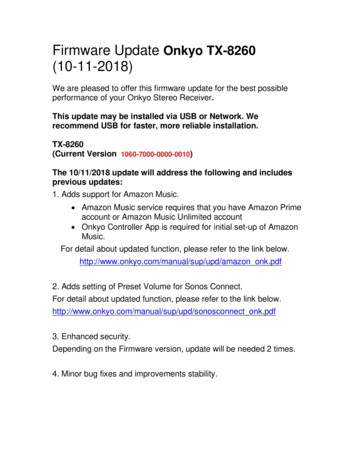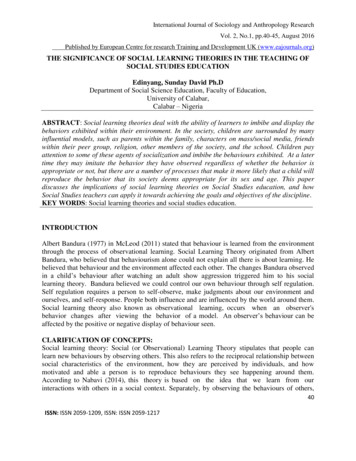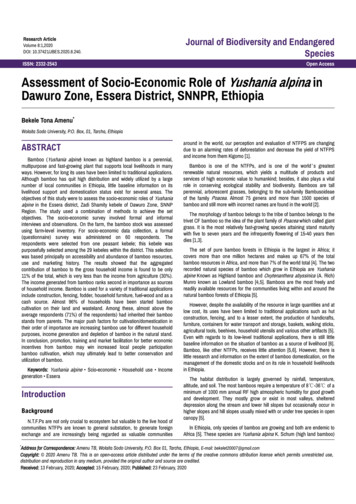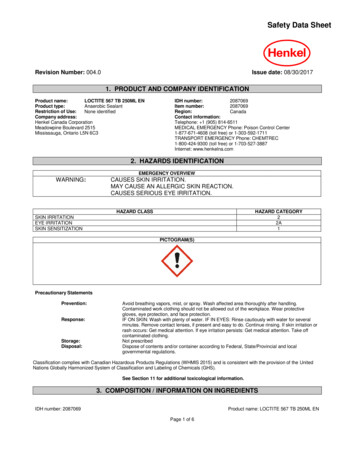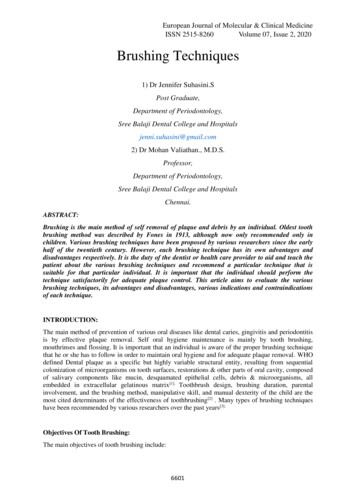
Transcription
European Journal of Molecular & Clinical MedicineISSN 2515-8260Volume 07, Issue 2, 2020Brushing Techniques1) Dr Jennifer Suhasini.SPost Graduate,Department of Periodontology,Sree Balaji Dental College and Hospitalsjenni.suhasini@gmail.com2) Dr Mohan Valiathan., M.D.S.Professor,Department of Periodontology,Sree Balaji Dental College and HospitalsChennai.ABSTRACT:Brushing is the main method of self removal of plaque and debris by an individual. Oldest toothbrushing method was described by Fones in 1913, although now only recommended only inchildren. Various brushing techniques have been proposed by various researchers since the earlyhalf of the twentieth century. However, each brushing technique has its own advantages anddisadvantages respectively. It is the duty of the dentist or health care provider to aid and teach thepatient about the various brushing techniques and recommend a particular technique that issuitable for that particular individual. It is important that the individual should perform thetechnique satisfactorily for adequate plaque control. This article aims to evaluate the variousbrushing techniques, its advantages and disadvantages, various indications and contraindicationsof each technique.INTRODUCTION:The main method of prevention of various oral diseases like dental caries, gingivitis and periodontitisis by effective plaque removal. Self oral hygiene maintenance is mainly by tooth brushing,mouthrinses and flossing. It is important that an individual is aware of the proper brushing techniquethat he or she has to follow in order to maintain oral hygiene and for adequate plaque removal. WHOdefined Dental plaque as a specific but highly variable structural entity, resulting from sequentialcolonization of microorganisms on tooth surfaces, restorations & other parts of oral cavity, composedof salivary components like mucin, desquamated epithelial cells, debris & microorganisms, allembedded in extracellular gelatinous matrix[1]. Toothbrush design, brushing duration, parentalinvolvement, and the brushing method, manipulative skill, and manual dexterity of the child are themost cited determinants of the effectiveness of toothbrushing[2] . Many types of brushing techniqueshave been recommended by various researchers over the past years[3].Objectives Of Tooth Brushing:The main objectives of tooth brushing include:6601
European Journal of Molecular & Clinical MedicineISSN 2515-8260Volume 07, Issue 2, 2020 To prevent plaque formationPlaque removalCleaning the tongueMassage the gingival tissueBRUSHING TECHNIQUES:1) Bass Method:FIG 1: Shows bass method of brushingPC: drchetan.comTechnique: The head of the brush is kept parallel to the occlusal plane, with the brush head coveringalmost 3-4 teeth starting from the distal most teeth of the arch. The bristles are placed at the gingival margin at an angle of 45 degrees to the long axis ofthe tooth[4]. Gentle vibratory pressure is given using short back and forth movement dislodging thetips of the bristles.The Bass technique places emphasis on the removal of plaque from the area above and justbelow the gingival margin[5].Indications: adaptable for open interproximal & cervical areas contour of the enamel & exposed root surfaces. Recommended for routine patients with or without periodontal involvement.Advantages: Effective for removing plaquebeneath gingivalmargin,cervical areas and sulcus Provides good gingival stimulationDisadvantages: cause injury to the gingival margin.6602
European Journal of Molecular & Clinical MedicineISSN 2515-8260Volume 07, Issue 2, 2020 Time consuming.Causes laceration of the gingiva2) Modified Bass Method/Sulcus Cleaning Method:FIG 2: Shows modified bass techniquePC: google.comTechnique: The head of the brush is kept parallel to the occlusal plane, with the brush head coveringalmost 3-4 teeth starting from the distal most teeth of the arch. The bristles are placed at the gingival margin at an angle of 45 degrees to the long axis ofthe tooth. Gentle vibratory pressure is given using short back and forth movement dislodging thetips of the bristles.Wainwright and Sheiham[7] reported that the most recommended method of toothbrushing was themodified Bass method. Alanazi et al [8]stated that the modified Bass method combined with a distaloblique method of holding the toothbrush is significantly effective in eliminating dental plaque.Modified Bass technique is one of the most recommended type of brushing technique as evidencefrom studies have suggested a better plaque control and a significant reduction in gingivalinflammation[9].Indications: Intrasulcular cleaning Routine oral hygiene measureAdvantages: Good gingival stimulation Good interproximal &gingival cleaningDisadvantages: Moderate dexterity of wrist is required6603
European Journal of Molecular & Clinical MedicineISSN 2515-8260Volume 07, Issue 2, 2020STILLMAN’S METHOD:Technique: Like the Bass method the filaments are placed at a 45 degree angle to the tooth.Unlike the Bass method the filaments are placed half in the sulcus and half on thegingiva.The same stroke is used as on the Bass method[10].Charter’s Method:FIG 3: Demonstrates Charter’s methodPC: slideplayer.comTechnique: Bristles are placed at an angle of 45 degrees to the gingiva with the bristles directed coronally Bristles are activated by mild vibratory strokes with the bristle end lying interproximallyIndications: Open interdental spaces with missingpapilla & exposed root surfaces FPD or orthodontic appliances Moderate gingival recession particularly interproximally Periodontal surgeryAdvantages: Technique specifically indicated in patients with orthodontic and prosthodontic appliancesEffective plaque removal.Suitable after periodontal surgeriesFones Technique:6604
European Journal of Molecular & Clinical MedicineISSN 2515-8260Volume 07, Issue 2, 2020FIG 4: Demonstrates Fones techniquePC: google.comTechnique: The brush is placed against a set of teeth and is moved in circular motion 4-5 times for eachset of teeth[17].Indications: Young children who want to do their own brushing but do not have the muscle developmentfor the techniqueAdvantages: Easy to learn Takes short time Physically/emotionally handicapped individualsDisadvantages: Trauma to gingiva Improper cleaning of interdental areasLEONARD’S TECHNIQUE:6605
European Journal of Molecular & Clinical MedicineISSN 2515-8260Volume 07, Issue 2, 2020FIG 5: Shows Leonard’s techniquePC: google.comFIG 6: Shows Leonard’s techniquePC: google.comTechnique: Bristles are placed at 90 degree angle to the facial surface on the clenched anterior &posterior teeth With the teeth edge to edge,place the brush with the filaments against the teeth at right angleto long axis of teeth6606
European Journal of Molecular & Clinical MedicineISSN 2515-8260Volume 07, Issue 2, 2020 Brush vigorously without great pressure with up and down stroke on tooth surface with aslight rotation after striking the gingival margin with forceAdvantages: Most convenient Effective for small children with deciduous teethDisadvantage: Interdental areas are not cleaned properlyHorizontal Scrub Technique:FIG 7: Horizontal scrub techniquePC: google.comTechnique: The bristles are placed at right angles to the long axis of the teeth and gentle horizontalscrubbing movement of the brush is performed[11].Advantages: Free style of brushing Requires vigorous horizontal,vertical& circular motionsDisadvantages: Ineffective at plaque removal Tooth abrasion & gingival recession6607
European Journal of Molecular & Clinical MedicineISSN 2515-8260Volume 07, Issue 2, 2020Several studies have reported the use of the horizontal scrub technique to be the method of choice inyoung children because of the inability to apply other tooth brushing methods. [12,13,14] The authorssuggested that horizontal scrub technique is a suitable way of tooth brushing in preschool children,considering the development of motor skills at that age.[13,14]Modified Stillman’s Technique:FIG 8: Shows modified Stillman’s TechniquePC: google.comTechnique: Bristles are pointed apically with an oblique angle to the long axis of the tooth & placedpartly on the cervical aspects of the teeth & partly on the adjacent gingiva. Bristles are activated by short back & forth motions & simultaneously moved in a coronaldirection following 20 strokes.Indications: Areas with progressing gingival recession & root exposure to prevent abrasive tissuedestruction Plaque removal from cervical areas below the height of contour of the enamel & fromexposed proximal surfacesAdvantages: This technique provides good gingival massage and inter proximal cleaning.6608
European Journal of Molecular & Clinical MedicineISSN 2515-8260Volume 07, Issue 2, 2020Disadvantage: Technique is difficult to learn and implement.Hirsfield’s Brushing Technique:The technique is same as the Charter’s method except in the maxilla and mandible are keptoccluded.The Hirschfeld’s technique is also a modification of the Fone’s technique where the circularmotion is much smaller and concentrated over the gingival crevice[15].Advantages: Provides additional stability and control to those who lack dexterity. Cheeks help in exerting pressure required to flex the bristles.Smith-Bell(Physiologic) Brushing Technique:Also known as Physiologic technique of tooth-brushing because the brushing method is the same asthat taken by the food during mastication.Technique: Bristles are placed at the height of the incisal edge or occlusal surfaces at an angle of 90degrees and moved in the gingival direction.Produces frictional action similar to that obtained from mastication of fibrous food.Suitable for patients having anatomically normal dentition.Advantage: Stimulates gingiva and improves blood circulation in connective tissue.Disadvantage: In existing pockets, this brushing technique tends to strip the tissue away from the teeth andfacilitates packing of debris into an open pocket.There does not appear to be any consensus by professionals on the best method of tooth brushing thathas to be followed by the general population. Frequency and duration of brushing are usually includedwith recommendations concerning the method of toothbrushing. Various studies have stated that thereis a wide diversity in the method of tooth brushing that was proposed by the dental heath careprovider[16,17].Direct communication through the dentist is one of the most effective and essential waysof improving the oral health status[18].Kropf et al suggested that modified bass and modified scrubmethods were most recommended by dentists when compared to other techniques[19]. Kremers et al.[20]and Zhang et al.[21] showed that interdental plaque was effectively removed by Bass technique than theother techniques.Anaise et al [22] observed that horizontal scrubbing method has more significantplaque-removing effect than the Roll, Charters, and modified Stillman methods.CONCLUSION: Depending on the individual cases, the techniques may have to be alteredto achieve themaximum beneficial effect. Reduction in plaque score was seen in Modified bass & horizontal scrubTechnique & least efficacy was seen in Fonestechnique[20,21].REFERENCES:6609
European Journal of Molecular & Clinical MedicineISSN 2515-8260Volume 07, Issue 2, 2020[1] World Health Organization Periodontal disease. Tech report seriesNo207. Geneva, USA, 1961.[2] Sharma S, Yeluri R, Jain A, Munshi A. Effect of toothbrush grip on plaque removal during manualtoothbrushing in children. Journal of Oral Science, 2012; 54(2):183-190.[3]. Poyato FM, Segura EJ, Bullón FP. Comparison of modified Bass technique with normaltoothbrushing practices for efficacy in supragingival plaque removal. Int J Dent Hyg. 2003 May1;1(2):110-4.[4]. BASS CC. An effective method of personal oral hygiene; part II. J La State Med Soc. 1954Mar;106(3):100-12. PMID: 13143356.[5] Bass C C. The optimum characteristics of toothbrushes for personal oral hygiene. Dental ItemsInterest 1948; 70: 921–934.[6]Ganss C, Schlueter N, Preiss S, Klimek J. Tooth brushing habits in uninstructed adults- frequency,technique, duration and force. Clin Oral Investig 2009; 13: 203–208.[7]Wainwright J, Sheiham A. An analysis of methods of toothbrushing recommended by dentalassociations, toothpaste and toothbrush companies and in dental texts. Br Dent J. 2014 Aug; 217(3):E5.[8]. Khalid Jamal Alanazi, et al. (2017) Influence of Tooth Brush Grips and Brushing Techniques onPlaque Removal Efficacy. J Dent Oral Health 4: 1-7.[9]. Poyato-Ferrera M, Segura-Egea J J, BullónFernández P. Comparison of modified Bass techniquewith normal toothbrushing practices for efficacy in supragingival plaque removal.[10] Stillman P R. A philosophy of treatment of periodontal disease. Dental Digest 1932; 38: 315–322.[11] Phinney D, Halstead J. Delmar’s dental assisting: a comprehensive approach. New York:Cengage Learning, 2003.[12] Kimmelman BB, Tassman GL. Research in design of children's toothbrushes. J DentChild. 1960;27:60.[13] McClure DB. A comparison of toothbrushing technics for the preschool child. J DentChild. 1966;33:205–10.[14] Rugg-Gunn AJ, Macgregor ID. A survey of toothbrushing behaviour in children and youngadults. J Periodontal Res. 1978;13:382–9.[15] O’Toole M T. Mosby’s medical dictionary. 9th ed. St Louis: Elsevier Health Sciences, 2013.[16] Dos Santos A, Nadanovsky P, de Oliveira B H. Inconsistencies in recommendations on oralhygiene practices for children by professional dental and paediatric organizations in ten countries. IntJ Paediatr Dent 2011; 21: 223–231.[17]Patil SP, Patil PB, Kashetty MV. Effectiveness of different tooth brushing techniques on theremoval of dental plaque in 6–8 year old children of Gulbarga. J Int Soc Prev Community Dent.2014;4:113–116. doi:10.4103/2231-0762.138305.[18] Chachra S, Dhawan P, Kaur T, Sharma AK. The most effective and essential way of improvingthe oral health status education. J Indian Soc PedodPrev Dent. 2011;29:216–21.[19] Kropf JL. Clinical Evaluation of Magnifying Lighted Mirror and Unwaxed Dental Floss as OralHygiene Adjuncts. Master's Thesis, Ann Arbor, University of Michigan, School Dentistry. 1971:124.[20] Kremers L, Lampert F, Etzold C. Comparative clinical studies on 2 toothbrushing methods--Rolland Bass technic. DtschZahnarztl Z. 1978;33:58–60.6610
European Journal of Molecular & Clinical MedicineISSN 2515-8260Volume 07, Issue 2, 2020[21] Zhang JH, Sha YQ, Cao CF. Comparative study of the effects of removing plaque by twotoothbrushing methods. Beijing Da XueXue Bao. 2005;37:542–4.[22] Anaise JZ. The toothbrush in plaque removal. ASDC J Dent Child. 1975;42:186–9.6611
European Journal of Molecular & Clinical Medicine ISSN 2515-8260 Volume 07, Issue 2, 2020 6601 Brushing Techniques 1) Dr Jennifer Suhasini.S Post Graduate, Department of Periodontology, . facilitates packing of debris into an open pocket. There does not appear to be any consensus by professionals on the best method of tooth brushing that
